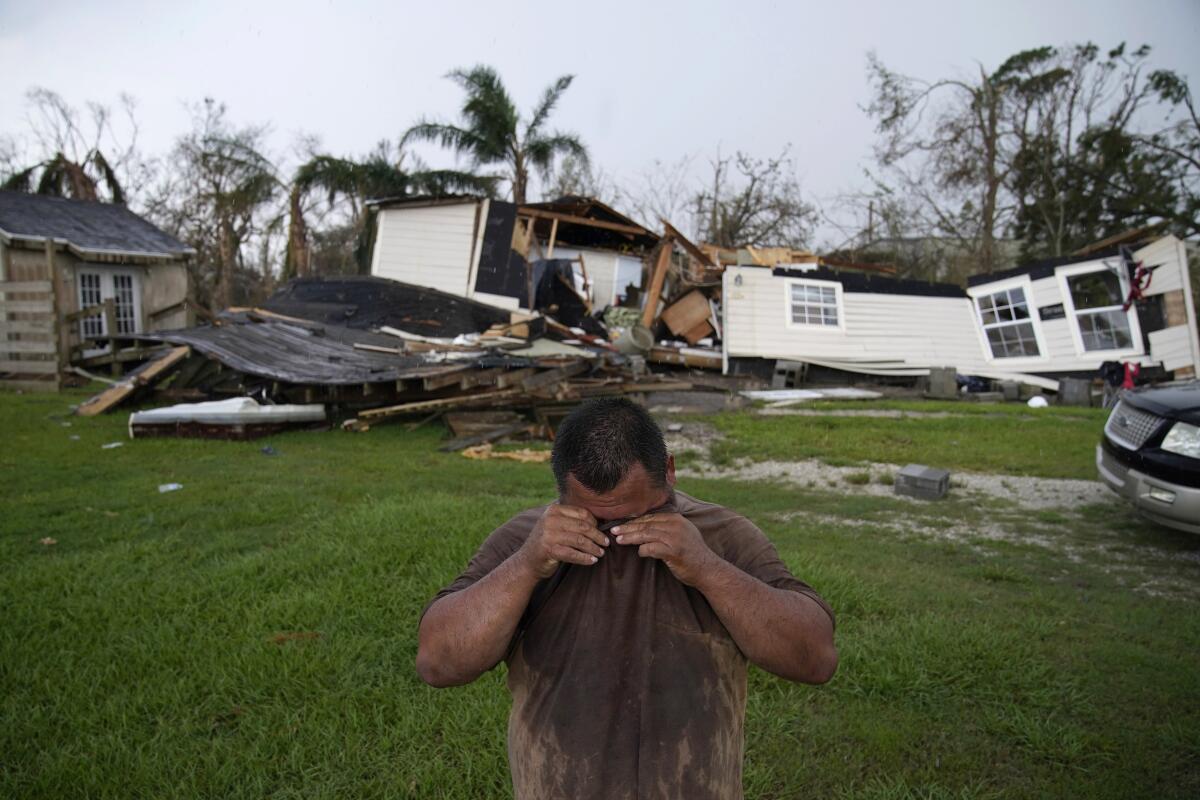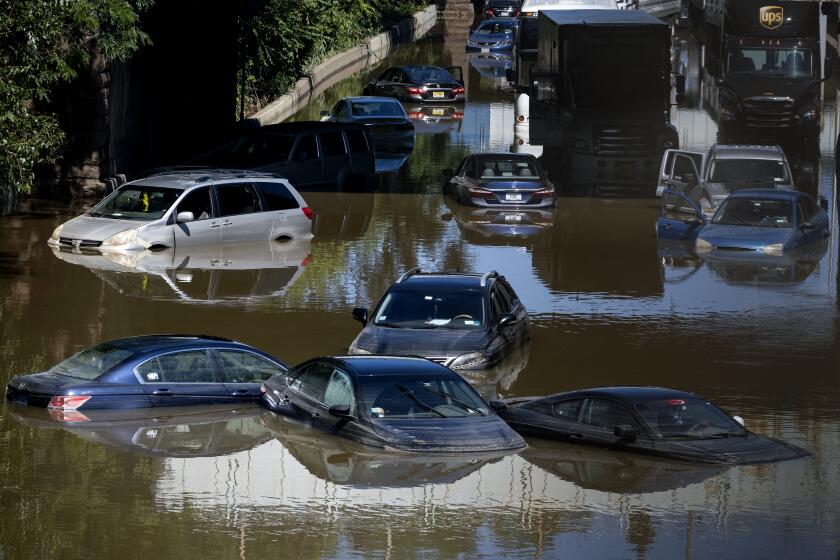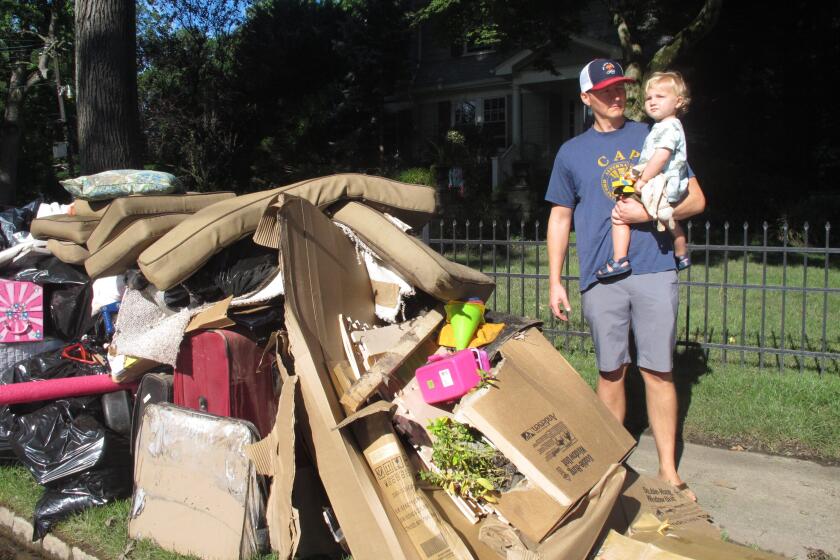Outside of New Orleans, an even longer road to Ida recovery

- Share via
HOUMA, La. — The COVID-19 pandemic claimed Kendall Duthu’s job as a cook at a jambalaya restaurant. Then Hurricane Ida claimed his house.
The 26-year-old resident of Dulac, La., is living out of his car with his girlfriend after Ida roared ashore a week ago Sunday, splintering homes in its path. Now he doesn’t know what’s next.
On Saturday, Duthu collected a container of red beans and rice from volunteers in nearby Houma who handed out ice, water and meals to shellshocked storm survivors. He stopped to eat inside his Infiniti, its windshield shattered.
“Next stop, I don’t really ... ,” he said, trailing off. “We’ve just been living day by day.”
Dulac and Houma are in Terrebonne Parish, among the hardest-hit areas of Louisiana battered to an unprecedented degree by Hurricane Ida. Though Louisiana’s largest electric utility, Entergy, estimates most residents in New Orleans will have power by Wednesday, recovery efforts outside of the city could be a much longer slog.
The Louisiana power grid’s failure in Hurricane Ida’s wake is familiar for Entergy Corp., which has grappled with outages after previous hurricanes
Meanwhile, residents continue to face food, water and gas shortages while battling heat and humidity.
Some parishes outside New Orleans were pummeled for hours by winds of 100 mph or more.
Fully restoring electricity to some of these southeastern parishes could take until the end of the month, Entergy President and Chief Executive Phillip May said.
Ida damaged or destroyed over 22,000 power poles, more than hurricanes Katrina, Zeta and Delta combined, an impact May called “staggering.” More than 5,200 transformers failed, and nearly 26,000 spans of wire — the stretch of transmission wires between poles — were down.
By Saturday morning, power was restored to about 282,000 customers from the peak of 902,000 who lost power after Ida.
Outside Dulac, 45-year-old shrimper Jay Breaux stood in front of his home, snapped open by the storm. Breaux could see a bed exposed through a cratered wall and a lawn chair dangling from the debris. But he smiled widely, saying his family wasn’t doing as badly as others.
“It don’t pay to cry about it,” he said of Ida, the latest storm to hit his small town along the bayou. “I got 10 or 12 of them things under my belt. But this one here is the worst.”
Fires, hurricanes and floods. Cities need a redesign. Plus: MOCA’s paranoid press strategies and Afghan art in the U.S., in our weekly arts newsletter
At least 16 deaths were blamed on the storm in Louisiana, Mississippi and Alabama. In the Northeast, Ida’s remnants dumped record-breaking rain and killed at least 50 people from Virginia to Connecticut.
Louisiana’s 12 storm-related deaths included five nursing home residents evacuated ahead of the hurricane along with hundreds of other seniors to a warehouse in Louisiana, where health officials said conditions became unsafe.
On Saturday evening, Dr. Joseph Kanter, a state health officer, ordered the immediate closure of the seven nursing facilities that sent residents to the Tangipahoa Parish warehouse facility.
“The lack of regard for these vulnerable residents’ well-being is an affront to human dignity. We have lost trust in these nursing homes to provide adequate care for their residents,” Kanter said.
As recovery efforts continued, state officials were monitoring a system of disturbed weather in Mexico’s Bay of Campeche that appeared set to move into the central Gulf of Mexico closer to Louisiana.
Louisiana Gov. John Bel Edwards said Saturday the state was planning an exercise to assess its emergency response if needed. Predictions so far don’t show the system strengthening into a hurricane, but he said “even if it’s a tropical storm, we’re in no state to receive that much rainfall at this time.”
“We can’t take the playbook we normally use because the people and assets are no longer where they would have been,” Edwards said. “How do you staff up shelters you need for the new storm and continue to test for COVID? My head’s getting painful just thinking about it.... We will be as ready as we can be, but I’m praying we don’t have to deal with that.”
Flood-stricken families and business owners in the Northeast are hauling waterlogged items to the curb and scraping away mud amid cleanup from Ida.
The lower Mississippi River reopened to all vessel traffic in New Orleans and key ports throughout southeastern Louisiana after power lines from a downed transmission tower were removed, the U.S. Coast Guard said.
New Orleans Mayor LaToya Cantrell said the city would offer transportation to any resident looking to leave the city and get to a public shelter.
By the end of Saturday, city agencies conducting wellness checks had evacuated hundreds of people out of eight senior living complexes where officials deemed conditions unfit for living. The coroner’s office is investigating four post-storm deaths that occurred at three of those facilities.
In suburban New Orleans, Jefferson Parish Sheriff Joseph Lopinto urged people “to calm down” as he announced Saturday that a man wanted in the shooting death a day earlier of another man during a dispute in a line at a gas station was in custody.
Meanwhile, Saturday, Coast Guard cleanup crews were responding to a sizable oil spill in the Gulf of Mexico after the storm. The spill, which is ongoing, appears to be coming from an underwater source at an offshore drilling lease about two miles south of Port Fourchon, La.
More to Read
Sign up for Essential California
The most important California stories and recommendations in your inbox every morning.
You may occasionally receive promotional content from the Los Angeles Times.
















